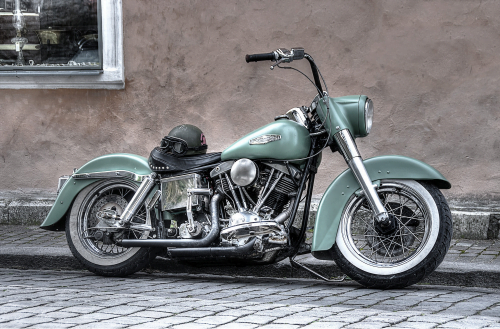THE RIGHT WAY TO PREPARE
Ace Your Newfoundland and Labrador Motorcycle Test
 So you’re eyeing the open road in Newfoundland and Labrador, ready to rev up a motorcycle and feel the breeze. Getting your license is key, but it’s not just about hopping on and hitting the gas. There’s a process—a few tests to ace first.
So you’re eyeing the open road in Newfoundland and Labrador, ready to rev up a motorcycle and feel the breeze. Getting your license is key, but it’s not just about hopping on and hitting the gas. There’s a process—a few tests to ace first.
We’ve got your back with this guide. You’ll learn how to start from scratch: what eligibility hoops you need to jump through, study tips for acing that knowledge test, and what skills will get scrutinized when you show off your riding chops.
And because we know staying safe is as important as feeling free on two wheels, we’ll cover essential safety gear, too. Ready for an upgrade? We touch on that also! By the end of this read, you’re closer to navigating those scenic routes legally—and safely.
Understanding the Newfoundland and Labrador Motorcycle License Process
Are you revving up to get your motorcycle license in Newfoundland and Labrador? Buckle up because it’s not just about feeling the wind on your face; you have a few legal hoops to jump through first. Here’s what you need to know.
Eligibility Criteria for Motorcycle Learners in Newfoundland and Labrador
The journey begins with making sure you fit the bill. You’ve got to be at least 16 years old—sorry, young daredevils—and call this rocky island home or plan to stay long enough for a full season of “The Bachelorette.” Also, if your eyesight makes text messages look like ancient hieroglyphs, grab some specs or contacts before taking the plunge.
A valid government-issued ID will seal the deal on proving who you are when walking into the Service NL Centre. Please don’t leave without checking their requirements list unless you enjoy surprise quizzes about personal identification.
Preparing for the Knowledge Test
Cramming time. Before hitting those open roads, a written test will ensure your noggin is packed with more than just helmet hair. Think of it as Jeopardy., but every category is “Motorcycle Safety.” Get ahead by tackling practice tests online—they’re free.
If books are more your speed than browsers, swing by any motor registration office for study materials that’ll teach everything from road signs that aren’t suggesting pizza stops to tricky maneuvers no arcade game can prepare you for.
The Motorcycle Knowledge Test Explained
You’ve studied hard (hopefully), so now show them what you’re made of. This isn’t an Instagram poll; each question needs attention since they’re multiple-choice—a wrong click won’t let another option slide into DMs begging for forgiveness later on.
Remember: keep calm and answer—even if some questions seem designed by evil geniuses bent on confusing everyone.
With these tips under your belt—or should we say helmet?—you’ll cruise through getting licensed faster than you can say “easy rider.” Keep the rubber side down, folks.
Eligibility Criteria for Motorcycle Learners in Newfoundland and Labrador
If you’re itching to feel the wind on your face as you cruise the roads of Newfoundland and Labrador, knowing if you’ve got the green light to start learning is crucial. The province has a clear-cut set of rules about who can hop onto a motorcycle with learner plates.
Age Requirements
No Young Guns Here
You’ve got to have seen at least 16 candles on your birthday cake before dreaming about revving up that bike engine. Only folks aged 16 or older are eligible to apply for a Class 6 Level I motorcycle permit in this neck of the woods.
Remember, if you’re under 19, there’s an extra hoop to jump through—parental consent. Your mom or dad needs to sign off on it because, let’s be real, they should probably know if their kid is going out vroom-vrooming into traffic.
Citizenship and Residency
Locals Only Please
Newfoundlanders and Labradoreans take pride in their own—and when it comes time for handing out permits, they prefer locals behind those handlebars. You’ll need proof that you’re not just passing through but living here with documents like a utility bill or lease agreement making your case stronger than Superman’s grip.
The Paperwork Tango
Dance Steps Include ID and Eye Tests
To get things rolling towards getting that coveted permit, strutting into Service NL with proper identification is key—a government-issued photo ID will do nicely here. Service NL Driver Licensing page. But wait. There’s more—you must also show them peepers work well enough by passing an eye exam because spotting potholes from afar helps avoid eating asphalt sandwiches while riding.
Preparing for the Knowledge Test
Gearing up to take your motorcycle knowledge test in Newfoundland and Labrador? You’re about to embark on a ride through the rules of the road, where every turn is a question, waiting for your answer. But fear not; with some savvy prep work, you’ll be cruising towards that learner’s permit.
Familiarize Yourself with the Handbook
First things first, get cozy with The Road Users Guide. This trusty manual isn't just bedtime reading; it's packed with everything you need to know. Think of it as your roadmap—without it, you might find yourself at a crossroads during the exam.
Bonus tip: don't just read it—digest it. Picture each scenario in your head like you’re already behind those handlebars because soon enough, you will be.Take Advantage of Practice Tests
No athlete would skip practice before game day—and neither should you. Sharpen those mental gears by taking advantage of free online practice tests designed for Newfoundland and Labrador riders. They say practice makes perfect, but I say practice makes passing possible.
Dive into sites like Find A Driving School Canada, which offer realistic questions that mimic what’s coming down the pike on test day.Create Study Habits That Stick
You've got this. Set aside time daily to review material from The Road Users Guide or challenge yourself with a few quiz questions—it’ll help ensure all that info sticks harder than asphalt on tires.
Sometimes, changing up where or how we study can keep our brains firing on all cylinders, too—so mix in some audio resources if available or form a study group so everyone gets their engines running smoothly on test time.THE RIGHT CHOICE
The Motorcycle Knowledge Test Explained
So, you’re gearing up to take the Newfoundland and Labrador motorcycle knowledge test? Think of it as your first pit stop on the road to freedom. But before you rev your engines, let’s talk about what this test looks like.
What’s On The Test?
The test isn't a monster hiding under your bed; it's more like a friendly quizmaster who wants to see if you've done your homework. It covers everything from traffic laws specific to motorcyclists, safe riding practices, and how not to become one with the pavement in an unfortunate way—essentially all things bike-related. Questions come at you in a multiple-choice format, so think "multiple guesses," but smarter because guessing won’t cut it here.
Service NL offers a wealth of resources, including practice tests. These will give you a taste of real questions—no surprises on game day.
Scoring Your Way To Success
To pass this bad boy and hit that sweet spot—a score of 85% or higher is needed. Less than that? You'll have another chance, but trust me when I say study hard and aim for gold out of the gate.
Surely, some butterflies are fluttering in your stomach by now—that’s normal. Remember, studying pays off more than wishing upon stars ever did. Get into those online handbooks and practice tests; they’re like treasure maps leading straight to success.
Diving Deeper Into Subjects
Riding requires both hands-on skills and brains brimming with know-how about road rules – we’re talking right-of-way protocols and down-to-weather tips for riders who brave any forecast thrown their way.
Traffic signs and signals tailored for two wheels? Check.
Navigating intersections without breaking a sweat (or anything else)? Got it.
Defensive driving tactics because sometimes other drivers don't get motorcycles? Necessary.
Practical Skills Assessment
So, have you mastered the written part of your motorcycle test in Newfoundland and Labrador? Give yourself a pat on the back, but don’t rev your engines yet. Now comes the real deal: showing off those riding skills during the practical assessment.
Safety First: Gear Up Properly
Before you even think about kicking that stand-up, ensure you’re dressed to impress—safety style. You’ll need a DOT-approved helmet that fits like it was made for you because it protects your noggin. Grab those gloves, boots that cover your ankles (no fancy flip-flops), long pants (not jeans with more holes than Swiss cheese), and a durable jacket. It’s not just about looking cool; it’s law.
You can find more information on gear requirements here.
The Maneuverability Tango
 Your bike should move like butter on hot pavement—smooth and responsive. The examiner will see how well you handle tight turns without wobbling or putting a foot down. Imagine dancing with your bike; every step counts.
Your bike should move like butter on hot pavement—smooth and responsive. The examiner will see how well you handle tight turns without wobbling or putting a foot down. Imagine dancing with your bike; every step counts.
You’ll weave through cones as if they were old friends at a party, swerve around obstacles like last-minute plot twists in an action movie—and do all this while maintaining proper speed control and signaling because nobody likes spoilers.
Owning the Road Rules
This isn’t Mad Max territory; rules are there for good reason. Signal intentions clearly—unless mind-reading helmets become a thing—and always check blind spots unless mirrors have suddenly developed x-ray vision overnight. Stopping completely at signs is not optional unless ‘Stop’ started meaning something else recently.
Lane positioning is key too—you want to be seen by drivers who might otherwise mistake their vehicle for Noah’s Ark—it needs room for everyone safely.
Remember these tips as if they were lines from your favorite song—the chorus of safety equipment requirements will help protect you. At the same time, maneuvers are verses showcasing skillful driving techniques that combine into one harmonious melody called ‘Passing Your Motorcycle Practical Test.’
Now get out there and ride like there’s no tomorrow, but please follow today’s road rules.
A SIMPLE, FUN WAY TO PREPARE
Safety Gear and Equipment Requirements
Before hitting the road to earn your stripes, ensure you’re decked out in the right gear. Newfoundland and Labrador don’t play regarding safety, so strap in, and let’s get your ducks in a row.
Mandatory Safety Apparel
Think of it as your armor against the unpredictable. You'll need an approved motorcycle helmet that fits like a dream—snug but not headache-inducing. And trust me, if it looks cool, that's just a bonus because safety trumps style on these tests.
Riding gloves are another must-have; they protect your hands from abrasions while giving you grip-on-steel control over your ride. Then there are boots – no flip-flops or sneakers here. They've got to cover those ankles because twists and scrapes aren't part of today’s agenda.The High Visibility Factor
You want drivers to see you coming from miles away—or at least have enough time to stop texting before they rear-end you. A high-visibility vest does wonders for this purpose during knowledge test strolls around the block or practical assessments weaving through traffic cones. Transport Canada suggests bright colors can really up your visibility game.
All-Weather Readiness
No one controls Mother Nature, but showing up rain-ready with waterproof outerwear could mean acing that test without looking like a drenched cat afterward—a definite plus if someone cute is watching.
In Newfoundland and Labrador, where the weather changes its mind more often than my Aunt Mabel at a shoe sale, layers are key; thermal liners under jackets keep Jack Frost from nipping too hard during those chilly morning rides.Navigating Road Rules and Regulations for Motorcyclists
So, you’re revamped to hit the Newfoundland and Labrador roads on two wheels? Cool. But before you twist the throttle, let’s talk about road rules that’ll keep your rubber side down.
Remember, folks: these aren’t just suggestions—they’re rules set by people who want us bikers to enjoy many rides into our grizzled old biker days. Stick by them while practicing with tools like Newfoundland & Labrador’s motorcycle practice tests, and soon enough, those roads will feel less like obstacle courses—and more like endless stretches of freedom.
Right Gear, Right Attitude
Your brain is precious cargo; strap a helmet on it. Make sure all your gear meets Transport Canada’s safety standards. It’s not just brilliant; it’s the law in Newfoundland and Labrador. And looking like a power ranger can be pretty awesome, too.Riding means sharing space with cars that have cozy metal shells around them—you don't. So visibility is key. Pop on some reflective or bright gear because being seen is better than being sorry.
The Dance of Lanes and Signals
Imagine lanes as dance floors—stay within yours unless you've got good reason to switch. Do not make sudden moves; signal well ahead so everyone knows what step you’re about to take next.If turning left at an intersection feels like doing the tango blindfolded, remember: position yourself carefully, yield to oncoming traffic and pedestrians first—that's how pros do it.
Keeping Your Distance
Tailgating isn’t cool—not at parties or behind other vehicles. Keep enough room between you and others so you won’t end up as an unwanted hood ornament if they stop suddenly.You’ll want enough space for safety and comfort—because riding should feel more like cruising along coastal highways rather than dodging potholes in rush hour traffic jams.
Renewing or Upgrading Your Motorcycle Permit
If you’ve been cruising the roads of Newfoundland and Labrador with a learner’s permit, it might be time to kick things up a notch. You know the drill: follow the rules and stay safe, but what about when your permit’s expiration date is waving at you from around the corner? Or maybe you’re ready to shed that ‘learner’ title for good? Here’s how you can renew or upgrade your motorcycle permit without sweating.
The When and How of Renewal
 Your motorcycle learner’s permit isn’t forever—it has an expiry date just like milk, but unlike sour milk, driving on an expired one won’t just leave a bad taste; it’ll land you in hot water. Check out the government’s page for specifics because timing is everything here. Most permits are valid for two years—plenty of time to get comfy on two wheels—but don’t wait until day 729 to renew.
Your motorcycle learner’s permit isn’t forever—it has an expiry date just like milk, but unlike sour milk, driving on an expired one won’t just leave a bad taste; it’ll land you in hot water. Check out the government’s page for specifics because timing is everything here. Most permits are valid for two years—plenty of time to get comfy on two wheels—but don’t wait until day 729 to renew.
To keep riding smoothly without any hiccups—or worse, taking public transit—you’ll need some paperwork (proof of ID should do), possibly an eye test (so make sure those peepers are sharp.), and yes—the dreaded fee. But think of it as investing in more open-road adventures.
Moving On Up: From Learner to Pro
When you’re feeling bold enough to trade your L-plate for something more permanent—a full license—that’s where real fun begins. This isn’t just any old test; this is proving ground time. You must have held that learners’ badge for at least 12 months first, though—and had zero suspensions during the last six if we’re getting technical.
You’ll face off against another knowledge exam because they want to ensure all that learning is stuck with you. And then there’s the road test – picture this as your motorcycling graduation ceremony. Show them every swerve-and-turn trick in the book while flaunting impeccable safety habits picked up along those practice runs using resources like practice tests available online.
